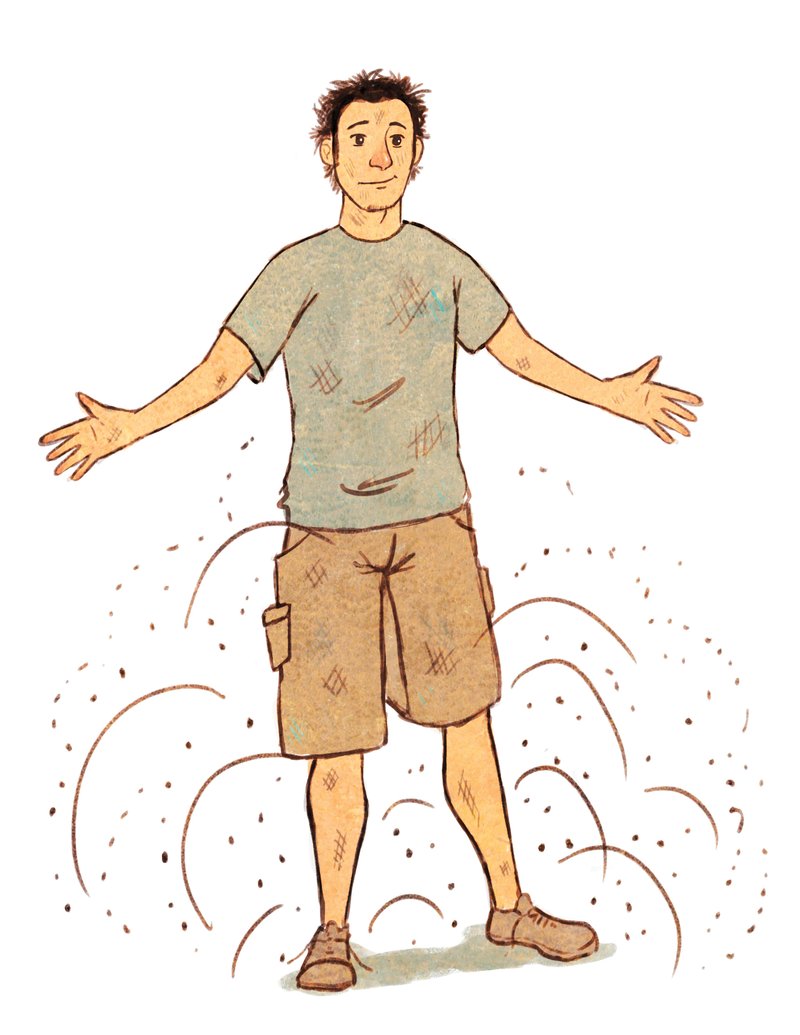Researchers studying how bacteria move through buildings have found evidence that we are all Pigpen.
Like the little boy in the Peanuts cartoon, a new study finds, humans travel about inside personal clouds of our own creation. But while Pigpen's was an obvious brown aura of dust from dirt, these real-world clouds are mostly invisible and full of microbes.
People exhale bacteria and other microbes and shake our microbe-laden skin and scalp cells into the air. Bacteria ride lint as it drifts off our clothing.
Like Pigpen, every move we make stirs up whatever live or dead bacteria, dust, lint, hair and other human debris happens to be lying around us.
What's more, researchers say, these invisible clouds can amount to a bioaerosol signature -- traceable, under the right conditions, to specific people.
Writing in the Sept. 22 edition of the journal PeerJ, a research team from the University of Oregon at Eugene describes experiments involving just the right conditions: scantily clad people sitting quietly alone in a sanitized, climate-controlled chamber. Eleven such people were found to emit detectable microbial clouds into surrounding indoor air.
Using a genetic analysis that looked for 12 species of bacteria, the researchers found that test subjects also dropped around them different, personal assortments of microbes.
The researchers observed how quickly heavier bacteria and bacteria-laden particles settled onto petri dishes set on the surfaces around their sedentary test subjects. And they saw that other microbes remained suspended in the air until they fetched up against something they stuck to -- air filters.
"Bacterial clouds from the occupants were statistically distinct," the researchers write, "allowing the identification of some individual occupants."
The study, "Humans Differ in Their Personal Microbial Cloud," can be downloaded free online at
peerj.com/articles/1258. It is part of a growing body of research inspired by the rise of new strains of antibiotic-resistant bacteria -- like antibiotic-resistant staph (MRSA) and tuberculosis.
Scientists have been hustling to understand where these terrifying disease agents come from and how they move around, especially in hospitals. Little is known about that. Although it has been documented, for instance, that humans transfer potentially harmful microbes from their bodies by touching the surfaces that surround them, that happens all the time. Why does it only sometimes spread disease?
Also, it has been established that the microbial communities -- microbiomes -- in occupied buildings are different from those of unoccupied buildings. But it isn't known what role those microbiomes inside buildings play in defending health or exactly how they develop. Do they reflect occupation by humanity in general or does the individuality of the humans involved matter?
While looking for answers, research has established that, for the most part, the microbes in and on healthy human bodies protect human health. And so, icky as encountering other people's microbe clouds might sound, the authors of the new study suggest that these clouds are just another way humans are well adapted to life among dizzyingly complex communities of unseen microbes.
The researchers note that "while indoors, we are constantly interacting with microbes other people have left behind on the chairs in which we sit, in dust we perturb, and on every surface we touch. These human-microbial interactions are in addition to the microbes our pets leave in our houses, those that blow off of tree leaves and soils, those in the food we eat and the water we drink."
Their new findings build on earlier research, they write, so that "it is becoming increasingly clear that we have evolved with these complex microbial interactions, and that we may depend on them for our well-being."
The study's lead author, James F. Meadows, directed the Arkansas Democrat-Gazette to two videos in which the climate-controlled chamber used in the new research can be seen:
• vimeo.com/106542009, titled "Clouds in a Box," in which the researchers scrub the chamber and set up tests.
• bit.ly/1PuaMXl, "When Good Bacteria Go Bad," a video by the American Museum of Natural History's Science Bulletins from 2013 that features the first of the experiments just reported by PeerJ. In this video, Meadows explains that trying to get rid of the bacteria on and around our bodies could be a bad idea.
"Now that we understand that there's all these bacteria floating around and that the vast majority of them are not bad for us," he says, "the conversation is changing from doing battle with bacteria to actually just managing our bacterial communities in a sensible way.
"When we knock back the bacteria on our hands with antibiotic hand sanitizer or when we take antibiotics when we don't need them, we very likely are making room for something else to come in and either colonize or actually to invade and affect our health."
ActiveStyle on 09/28/2015
